Cheltenham and District Light Railway
History
Cheltenham's 3ft 6ins-gauge overhead electric tramway system began life in 1896 when its promoter — Thomas Nevins, an Irish-American entrepreneur — approached Cheltenham Council to seek their buy-in for a scheme to build and operate a tramway within its environs. Unfortunately, the approach merely kicked off a protracted discussion amongst the conservative grandees of Cheltenham, many of whom regarded a tramway as an outrageous disfigurement of their beautiful town. Although Nevins' initial proposal was rejected, following further discussions on just about everything possible, including the routes, the gauge and the precise form of electric traction, all of which the council seemingly had a fixed view on, Nevins eventually returned towards the end of 1898 with a proposal that the council felt able to support. Around the same time, Nevins registered a new company — the Cheltenham and District Light Railway Company — to finance and operate the new system.
Although the application for a Light Railway Order was delayed by yet more objections — including from the council — it was finally granted on the 23rd June 1899. The initial order was for a 3.5-mile line running roughly northeastwards from Pitville Circus, which itself was northeast of the town centre, to Cleeve Hill. This was joined on the 12th January 1900 by powers for an extension running southwestwards from Pitville Circus to Lansdowne Castle, a distance of 2.25 miles.
Construction did not begin until February 1901, the council yet again desiring to have an input to all aspects of the tramway prior to work commencing. The construction gangs, as well as the infrastructure (e.g., the rails) and the first batch of eight tramcars all came from America, the system finally opening to the public on the 17th August 1901. Unfortunately, a fatal accident, which took place during testing on the steep section leading up to Cleeve Hill, resulted in the Board of Trade imposing a restriction on the carriage of passengers on the upper decks of tramcars working over this section.
Passenger loadings were good, the company quickly submitting a proposal for further extensions — southwards to Leckhampton and southeastwards to Charlton Kings — which were granted by the Light Railway Commissioners in May 1902. The council, however, soon started complaining about the standard of work and the materials used on the initial lines, until the company pointed out that the materials were as specified by the council, and were laid under the supervision of the Borough Surveyor. Matters were not helped by the sudden death of Nevins in August 1902, his son subsequently taking over the reins. Although the company bought off the omnibuses that were plying over some of the planned new routes, construction did not start until the 28th September 1904, the lines finally opening on the 29th March 1905. This took the total route mileage to 10.22 miles (built on the single line and passing loop principle), eight new tramcars being ordered to work the new lines.
The company settled down to a moderately profitable existence, briefly adding a motorbus service on the 31st May 1913, before selling out to Balfour, Beatty and Company Limited in 1914, a company which had interests in several UK tramway systems, and which placed the C&DLRCo under the control of one of its holding companies, the Tramways Light and Power Company (the Midland Counties Electric Supply Company from 1921).
The Great War quickly brought the omnibus service to an end, the sole bus being requisitioned by the military. Restrictions on the acquisition of new materials, as well as the loss of skilled staff to the war effort, primarily the armed services, led to a make-do-and-mend approach, the tramway infrastructure and the services suffering accordingly. Following the end of the conflict, vastly increased costs (men and materials) and statutory low fares meant that the company was in no position to fund the investment needed to put the system back in long-term good order. Despite this, three new tramcars were purchased in 1921 to replace worn-out vehicles, though after this all that could be done was to rebuild three existing tramcars and obtain two second-hand from the nearby Worcestershire system, which closed in 1928.
Three new omnibuses were purchased in 1924 and services restarted after a ten-year hiatus, these being followed by one more in 1925 and another three in 1928.
The company was unable to pay a dividend after 1925, so it was only a matter of time before the ever-more decrepit tramway would have to close, passenger numbers and takings falling by circa 20% over peak figures. The company proposed to submit a bill to close the tramway and replace the services with either motorbuses or trolleybuses, which once again caused the council to swing into action, this time strenuously objecting to the extra wire that the trolleybuses would need, despite the fact that they would have used electricity from the council-owned power station. The council had its way, and in return for not opposing the bill, it agreed not to purchase the tramway on the last day of 1931, as was its statutory right, as long as the company only obtained powers for motorbuses.
The bill received Royal Assent on the 10th May 1929, as a result of which the company name was formally changed to the Cheltenham District Traction Company. As soon as the motorbuses began arriving, services were withdrawn, the final tram running on the 31st December 1930.
Uniforms
Motormen and conductors were issued with single-breasted tunics with five buttons (almost certainly brass, and uniquely for a UK tramway system, bearing a grade — see link), two breast pockets (with button closures) and stand-up collars; the latter initially carried individual brass system initials ('C & D L R') on the bearer's left-hand side, though they were soon split across both collars, 'C & D' on the bearer's right-hand side and 'L R' on the left-hand side. Caps were of the drooping-peak type; they initially carried an oval cloth cap badge bearing system initials ('C & D L R') above the grade ('CONDUCTOR' is known), both in block capitals. The cloth cap badge was quickly displaced by standard, off-the-shelf, script-lettering grade badges, either 'Motorman' or 'Conductor', which were presumably in brass to match the buttons. At some point in the late-Edwardian era, the drooping-peak caps were superseded by tensioned-crown (top) peaked caps, which continued to carry script-lettering grade badges. With the exception of the caps, the uniform essentially remained unchanged right through to the closure of the system on the last day of 1930.
Tramcar crews were also provided with double-breasted topcoats with five pairs of buttons; these coats came in two basic styles, an overcoat with lapels (for conductors only), and a lancer-style greatcoat (with buttons narrowing from top to bottom) with high fold-over collars and epaulettes (for motormen and inspectors). Photographs suggest that apart from the buttons, these coats were unmarked, i.e., devoid of insignia.
The company also employed the services of parcels boys to support the successful parcels services that it operated. The uniform appears to have been identical to those worn by motormen and conductors, though what cap badges were worn remains unknown.
Inspectors wore uniforms that were effectively identical to those worn by tramcar staff, the sole difference in the early days being in the script-lettering grade badge — 'Inspector' — worn on the drooping-peak caps; this badge appears to have been brass rather than embroidered, as was usually the case with this grade on other systems. The drooping-peak caps were eventually superseded by tensioned-crown peaked caps, very probably at the same time as these were introduced for tramcar crews; the new caps still bore the grade, 'Inspector' in script-lettering, but now embroidered. The only other change to the senior staff uniform was in the collar insignia, the 'C & D' and 'L R' brass initials giving way to embroidered, script-lettering grade badges. Surprisingly, the chief inspector also wore the same style of uniform as inspectors and tramcar crews, but with embroidered 'Chief Inspector' insignia on his jacket collars and cap.
In common with many tramway systems across the United Kingdom, the C&DLRCo employed female staff during the Great War — as conductresses and subsequently also as inspectresses (at least one) — to replace male staff lost to the armed services. The last lady employee was released on 3rd October 1919. Surviving photos are unfortunately of poor quality, though they do reveal enough to say that female staff were issued with single-breasted, tailored jackets with four or five buttons and lapels; a long matching skirt was also worn. Headgear appears to have taken the form of a wide-brimmed straw bonnet, though this may have been specifically for summer use. It is assumed that these hats bore the standard script-lettering grade badges worn by male tramcar crews, though this cannot be stated with certainty.
Further reading
For a history of the Cheltenham and District Light Railway, see 'Cheltenham's Trams and Early Buses' by Colin Martin; Tempus Publishing Limited (2001).
Images
Motormen and conductors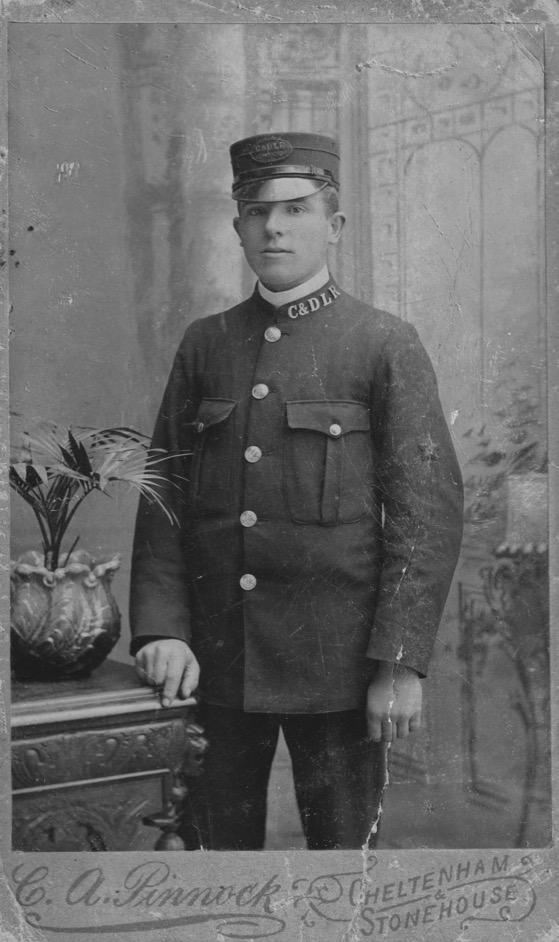
A superb studio portrait of a Cheltenham and District Light Railway conductor — photo undated, but very probably taken around the time of opening, i.e., 1901. The photograph was taken in the studios of C A Pinnock of Cheltenham and Stonehouse. Author's Collection.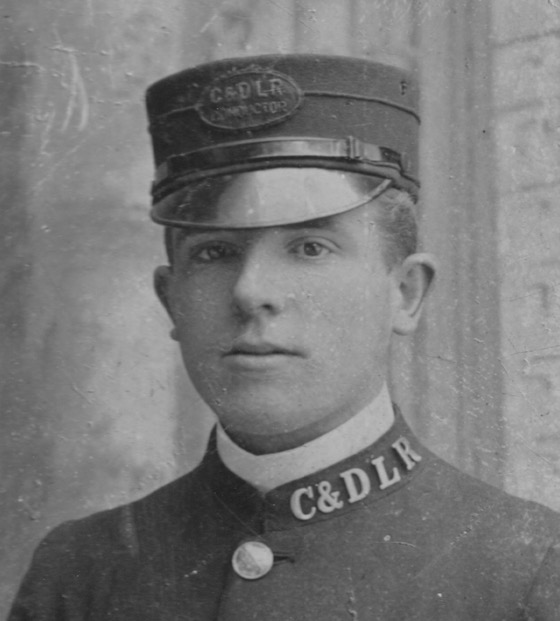
An enlargement of the above photograph showing the cap and collar insignia, as well as the pattern of uniform button (see link).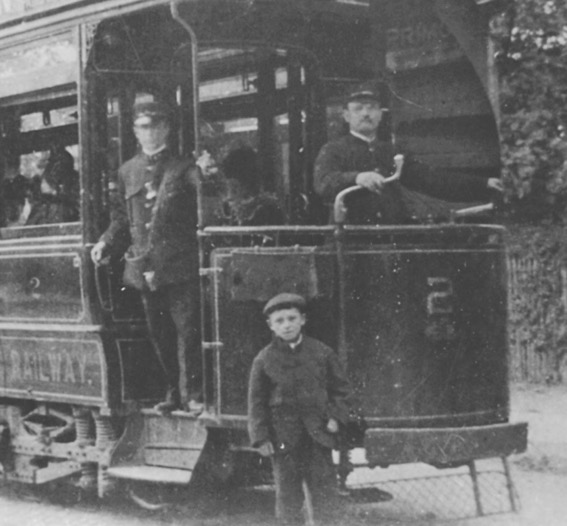
USA-built Tramcar No 2 with crew at the Lansdowne Castle terminus some time between 1902 and 1905. Photo courtesy of the Tramways and Light Railway Society, with thanks to David Voice.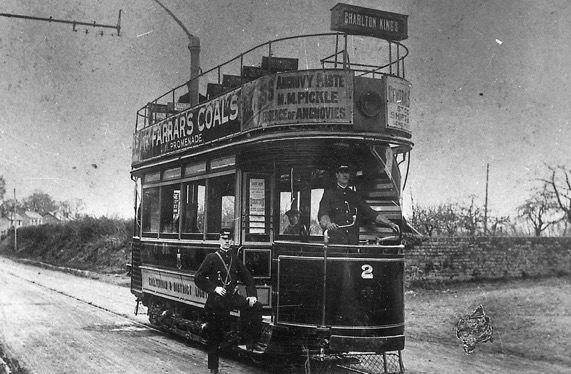
Tramcar No 2 again, this time at the Charlton Kings terminus, and in a later livery — photo undated, but probably taken in the mid-Edwardian era. Photo courtesy of the Colin Martin Collection.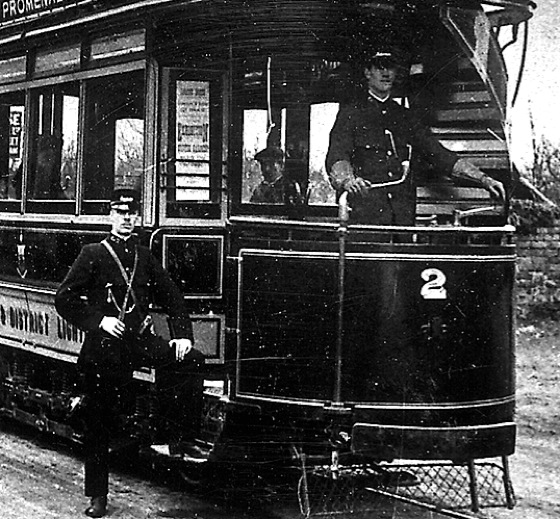
An enlargement of the above photograph, showing the crewmen, both of whom have insignia on both collars, as well as script-lettering grade badges on their caps.
Standard off-the-shelf script-lettering cap badges of the type used by the Cheltenham and District Light Railway Company from the early-Edwardian era onwards — brass. Author's Collection.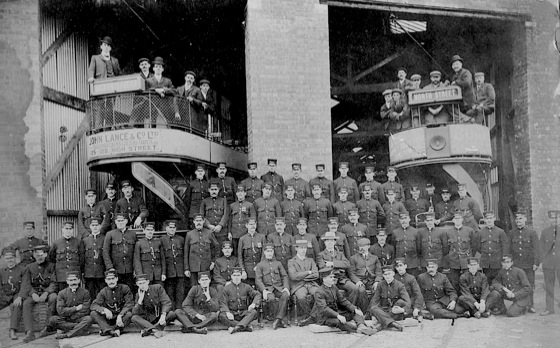
A staff photo taken at St Marks Depot, circa in 1905. All the uniformed staff (tramcar crews and senior staff) are wearing the same uniforms and drooping-peak caps. Photo courtesy of the Colin Martin Collection.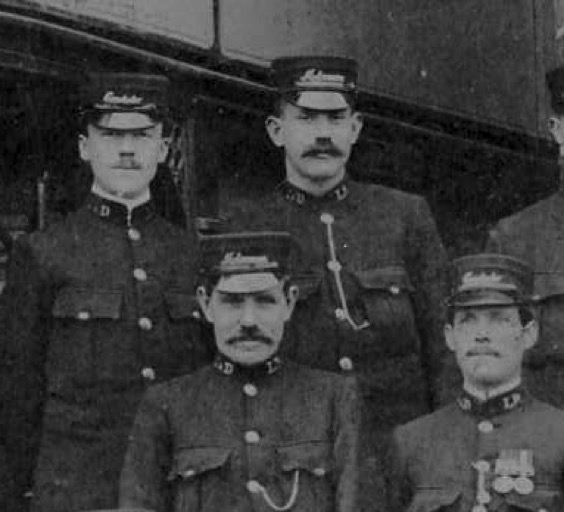
An enlargement of the above photograph showing details of the uniform jackets, caps and badges. The bearers' right-hand collars carry 'C & D' initials and the left, 'L R', whilst the caps carry standard script-lettering grade badges.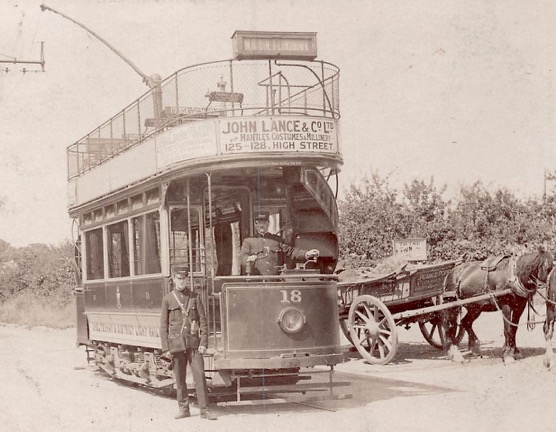
Another shot taken at what is probably the Lansdowne Castle terminus, this time of Tramcar No 18 — photo undated, but more than likely taken within a year or so of its delivery in 1905. Photo in the public domain.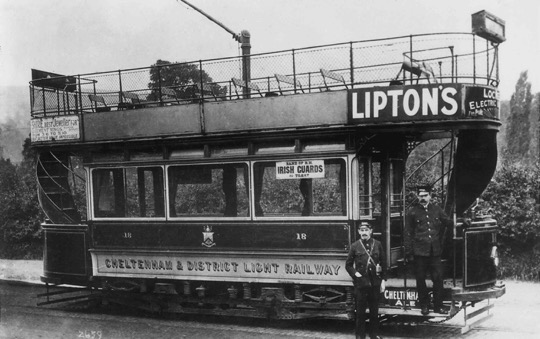
Tramcar No 18 again, but this time captured at the Leckhampton terminus — photo undated, but probably taken in the late-Edwardian era. Photo courtesy of the Colin Martin Collection.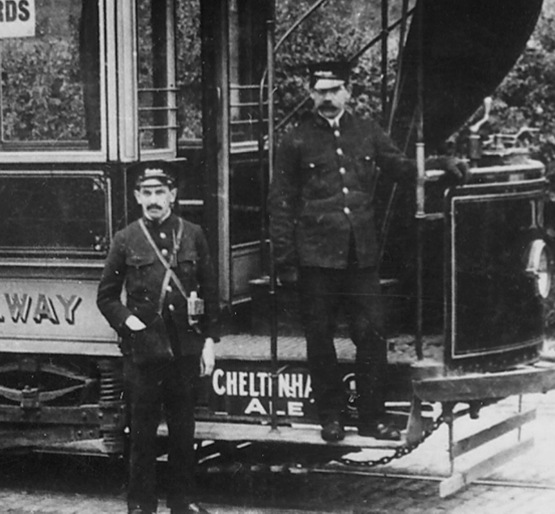
An enlargement of the above photograph showing the conductor and the motorman; although the uniform jackets are unchanged from the earlier images above, both men are now wearing tensioned-crown peaked caps.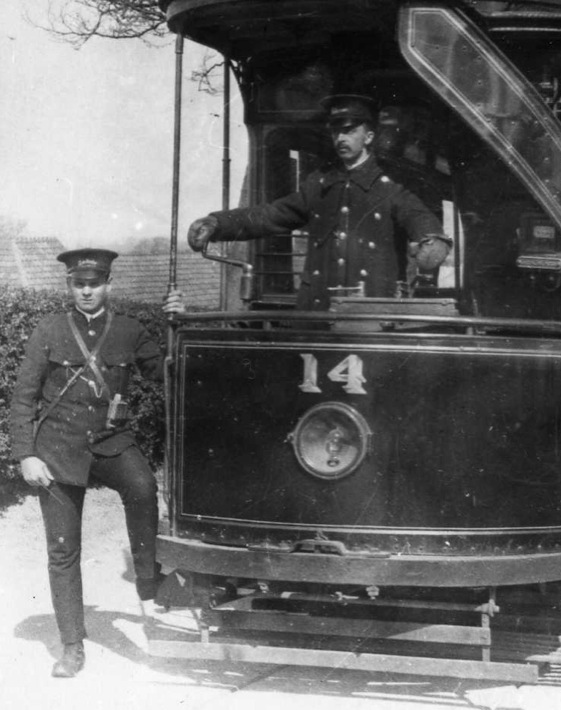
Conductor "Ossie" Wildsmith and Motorman Bill Austin with Tramcar No 14 at the Leckhampton terminus — photo purportedly taken in 1912. Photo courtesy of the Colin Martin Collection.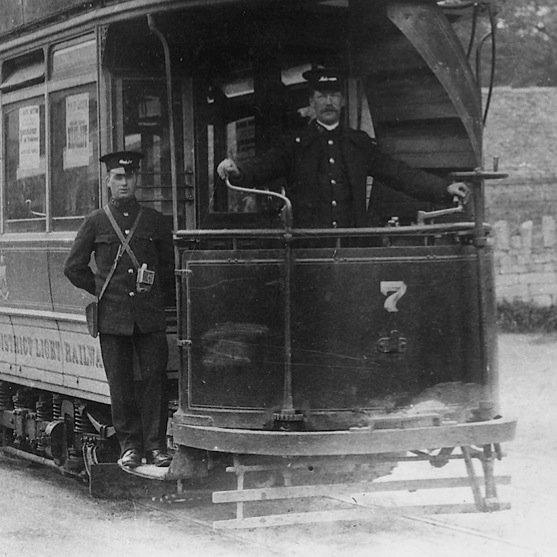
Tramcar No 7 and crew at Southam — photo undated, but probably taken shortly before the Great War. Photo courtesy of the Colin Martin Collection.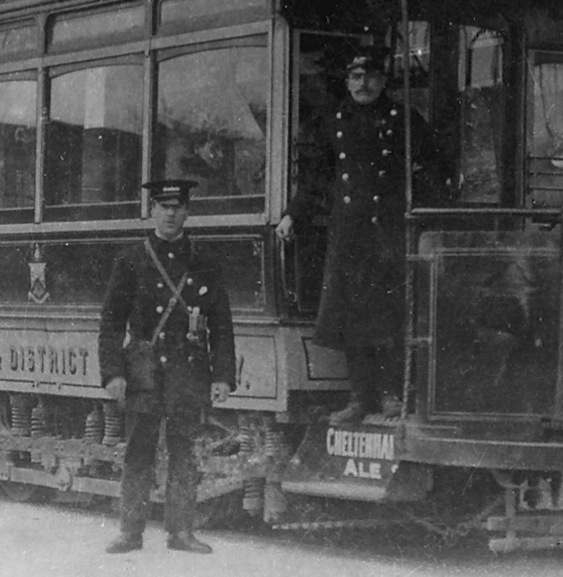
The crew of Tramcar No 7 pose for the cameraman at the Cleeve Hill terminus — photo undated, but probably taken just prior to or just after the Great War. The conductor is wearing an overcoat, the motorman a lancer-style greatcoat. Photo courtesy of the Colin Martin Collection.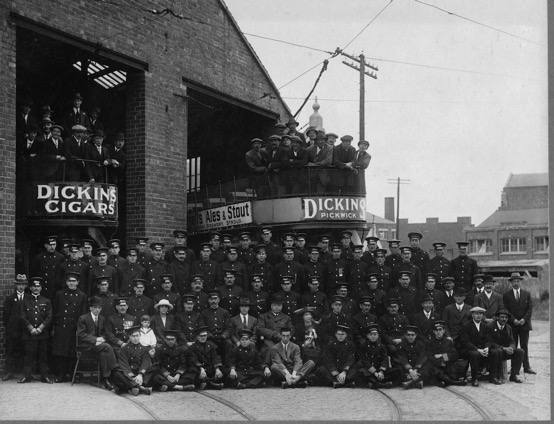
A staff photo taken outside the tramcar sheds at St Marks in 1923. Photo courtesy of the Colin Martin Collection.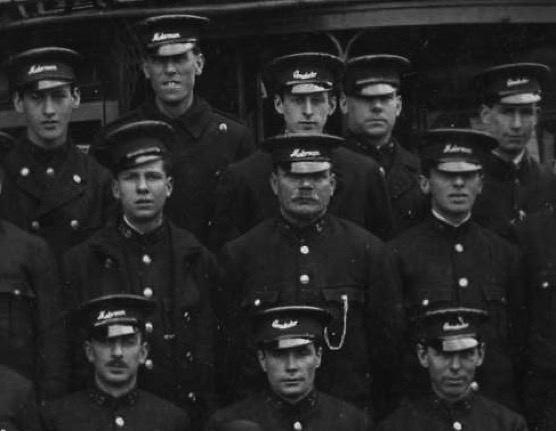
An enlargement of the above photograph showing a group of motormen and conductors. Photo courtesy of the Colin Martin Collection.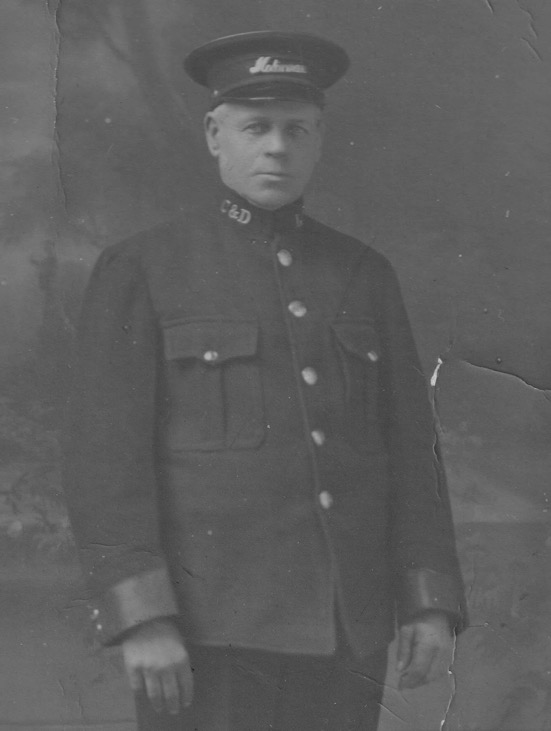
Motorman W. Townsend of Kingswood— photo dated '1920s'. Author's Collection.
Senior staff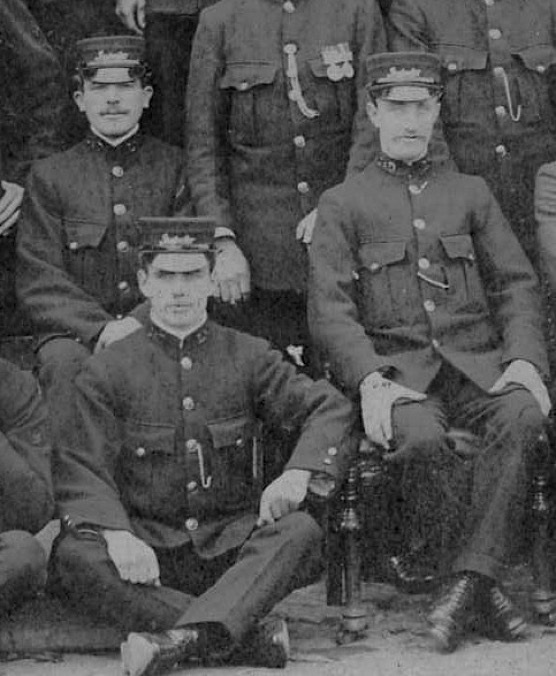
An enlargement of the c1905 staff photograph above, showing three inspectors. The uniforms only appear to differ from those of the tramcar staff in one respect, namely, a script-lettering 'Inspector' cap badge, which would appear to have been metal (brass) rather than the usual embroidered cloth, as was frequently the case on other systems. Photo courtesy of the Colin Martin Collection.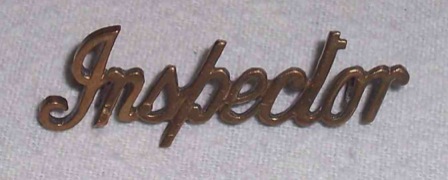
Script-lettering 'Inspector' cap badge of the type worn in the early days of the C&DLRCo system — brass. Author's Collection.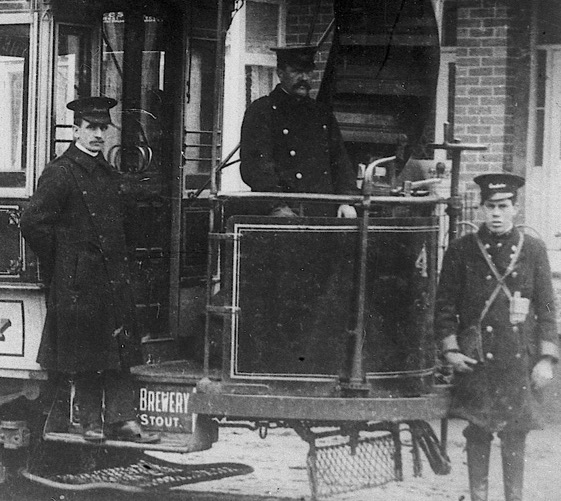
An inspector, in greatcoat, stands on the steps of Tramcar No 4 at Oaklands in Prestbury Rd, on the route to Cleeve Hill — photo undated, but probably late Edwardian. By this time, the early drooping peak caps of both tramcar crews and senior staff had been superseded by tensioned-crown peaked caps. Photo courtesy of the National Tramway Museum; background information from Colin Martin.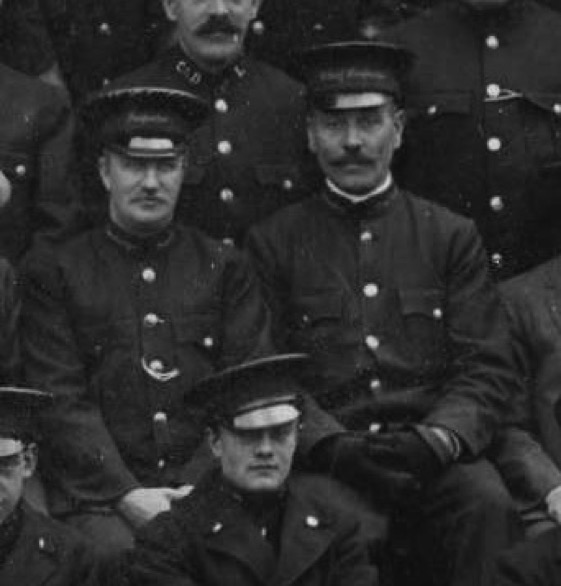
An enlargement of the 1923 staff photo above, showing Inspector Bill Flook (left) and Chief Inspector Harry Hales (right). Photo courtesy of the Colin Martin Collection.
Female staff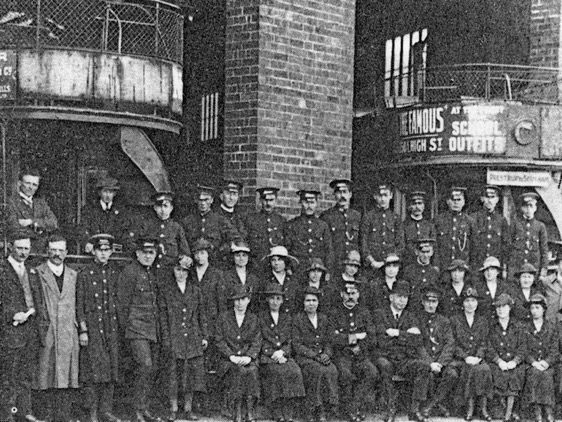
A staff photograph taken outside St Marks Depot showing a large number of female employees — photo undated, but almost certainly taken during or shortly after the Great War. Photo courtesy of the Colin Martin Collection.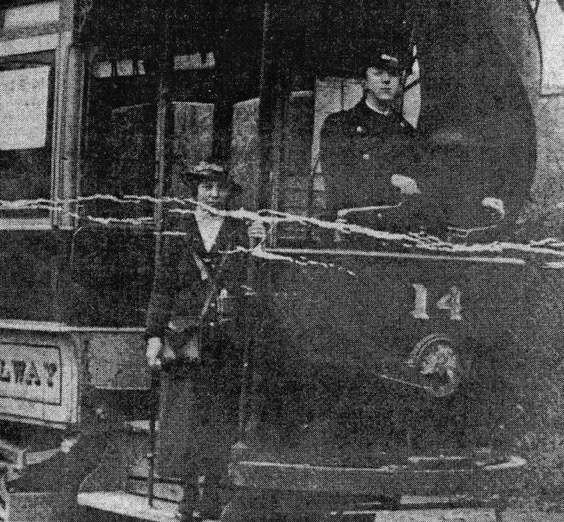
A poor quality but rare photo of a C&DLRCo conductress aboard a tramcar (No 14) — photo undated, but almost certainly taken during the Great War. Photo courtesy of the Colin Martin Collection - source unknown.